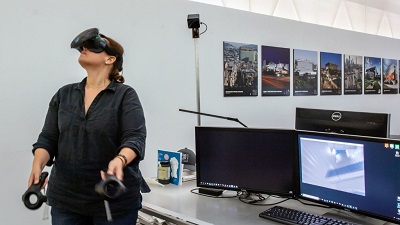 Friday, July 26, 2024
Friday, July 26, 2024  Friday, July 26, 2024
Friday, July 26, 2024 

In the studios of Morphosis Architects in Culver City, it is possible to step into the lobby of the new Orange County Museum of Art — even though construction on the museum, which will occupy an empty lot in Costa Mesa, isn’t scheduled to begin until sometime next year. By donning a pair of virtual reality goggles, however, you can stand before the planned museum’s large outdoor plaza at the Segerstrom Center for the Arts and step into the soaring atrium, where, if you look up, you’ll see a pair of sky bridges and a skylight.
Two-dimensional renderings (such as the ones you see on this page) can deliver a general idea of a building’s form and scale. But virtual reality’s uncanny ability to convey a sensation of depth and three-dimensionality can create the impression that you are standing in the middle of OCMA’s lobby in Costa Mesa — all without leaving the technology desk at Morphosis.
“It is total immersion,” says Arne Emerson, who oversees business development at the firm. “Virtual reality is the closest thing to seeing that is on a one-to-one scale.”
Click here to sign-up and receive the Weekly Round Up in your inbox every Saturday
For centuries, architects have employed drawings and models to display and explain design plans. Virtual reality has turned things up a notch — some architects use the technology because it not only allows them to see a proposed building, it lets them get a sense of what it might feel like.
“I’m playing with time,” says Thom Mayne, the Pritzker Prize-winning founder of Morphosis. “I’m walking through the building before it is built.”
On a more practical level, VR also allows non-architects — the public or a client — to register architectural concepts in more accessible ways.
“We talk about 3-D space all day long,” says Kerenza Harris, who serves as director of advanced technology at Morphosis. “We don’t understand the difficulty a lay person has in understanding 3-D space sometimes.”
OCMA Director Todd D. Smith says the museum trustees recently paid a visit to Mayne’s studio to have a look at the current iteration of the design..
“It was the first time any of the trustees experienced it and it gave them an easier way to talk about the building,” he says. “It really brought it home. To stand there and see how it works. It was fascinating as a client.”
VR has historically been hyped to revolutionize film and gaming, but as the goggles become more economical and processing speeds are improved, the technology is now becoming more accessible to architects and designers.